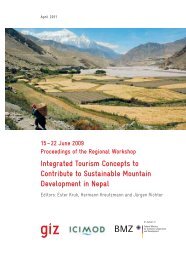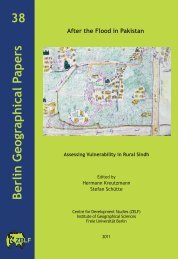Pastoralism and Rangeland Management on the Tibetan Plateau in ...
Pastoralism and Rangeland Management on the Tibetan Plateau in ...
Pastoralism and Rangeland Management on the Tibetan Plateau in ...
Create successful ePaper yourself
Turn your PDF publications into a flip-book with our unique Google optimized e-Paper software.
has been put forward. The government also rewards <strong>the</strong> slaughter of livestock<br />
through cash awards, is improv<strong>in</strong>g <strong>the</strong> <strong>in</strong>frastructure <strong>in</strong> pastoral areas, is promot<strong>in</strong>g<br />
universal free medical care <str<strong>on</strong>g>and</str<strong>on</strong>g> n<strong>in</strong>e-year compulsory educati<strong>on</strong> <str<strong>on</strong>g>and</str<strong>on</strong>g><br />
is <strong>in</strong>creas<strong>in</strong>g poverty alleviati<strong>on</strong> <str<strong>on</strong>g>and</str<strong>on</strong>g> development efforts to help low-<strong>in</strong>come<br />
families <strong>in</strong> pastoral areas. These efforts <strong>in</strong>clude rais<strong>in</strong>g <strong>the</strong> number of livestock,<br />
build<strong>in</strong>g stalls <str<strong>on</strong>g>and</str<strong>on</strong>g> sheds, fenc<strong>in</strong>g rangel<str<strong>on</strong>g>and</str<strong>on</strong>g>s <str<strong>on</strong>g>and</str<strong>on</strong>g> encourag<strong>in</strong>g alternative<br />
sources of <strong>in</strong>come. These efforts have brought tremendous transformati<strong>on</strong>s <strong>in</strong><br />
pastoral areas. However, if a huge disaster strikes aga<strong>in</strong>, we will still have to<br />
pay a great price because we have not repaired <strong>the</strong> most vulnerable l<strong>in</strong>k <strong>in</strong> <strong>the</strong><br />
traditi<strong>on</strong>al pastoralist cha<strong>in</strong>.<br />
2 Re-c<strong>on</strong>ceptualiz<strong>in</strong>g traditi<strong>on</strong>al <str<strong>on</strong>g>Pastoralism</str<strong>on</strong>g><br />
The characteristics of traditi<strong>on</strong>al pastoralism have often been described <str<strong>on</strong>g>and</str<strong>on</strong>g><br />
dist<strong>in</strong>guished <strong>on</strong> <strong>the</strong> basis of <strong>the</strong>ir typology. In additi<strong>on</strong> to <strong>the</strong> well-known<br />
aspects related to term<strong>in</strong>ology such as nomadism, self-sufficiency <str<strong>on</strong>g>and</str<strong>on</strong>g> seclusi<strong>on</strong>,<br />
<strong>the</strong>re have to be highlighted aspects of self-sufficiency <str<strong>on</strong>g>and</str<strong>on</strong>g> short producti<strong>on</strong><br />
cha<strong>in</strong>s. We will first look at <strong>the</strong> follow<strong>in</strong>g survey of a pastoral village (Table 1),<br />
<str<strong>on</strong>g>and</str<strong>on</strong>g> <strong>the</strong>n discuss two specific issues.<br />
Table 1: Initial weights (<strong>in</strong> kg) for different age cohorts of yaks before <strong>the</strong><br />
fatten<strong>in</strong>g process <strong>in</strong> 2009<br />
Age 3 years 4 years 5 years 6 years 7 years 8 years<br />
weight 96.5 148.5 170.7 209.6 226.9 263.4<br />
Source: Meng 2009<br />
Sibu Village (Sibu Ranch orig<strong>in</strong>ally) of Tashi Gang Town, Maizhokunggar<br />
County, is a traditi<strong>on</strong>al yak-keep<strong>in</strong>g village. There are 215 households, 1,360<br />
people <str<strong>on</strong>g>and</str<strong>on</strong>g> seven thous<str<strong>on</strong>g>and</str<strong>on</strong>g> yaks <strong>in</strong> <strong>the</strong> village. The survey covered 172 households,<br />
1,089 people, <str<strong>on</strong>g>and</str<strong>on</strong>g> 6,494 yaks, account<strong>in</strong>g for about four fifths of <strong>the</strong><br />
total village households <str<strong>on</strong>g>and</str<strong>on</strong>g> <strong>the</strong>ir livestock. The average household surveyed<br />
raised 37.8 yaks. Of all <strong>the</strong> yaks, 38.1 % were <strong>on</strong>e to four years old, 33 % were<br />
five to eight years old <str<strong>on</strong>g>and</str<strong>on</strong>g> 28.9 % were eight years or older. The ratio of female<br />
to male was 62:38, with a calv<strong>in</strong>g rate of 7.2 % <str<strong>on</strong>g>and</str<strong>on</strong>g> a slaughter<strong>in</strong>g (<strong>in</strong>clud<strong>in</strong>g<br />
death) rate of 12.3 % <strong>in</strong> 2008. Of <strong>the</strong> slaughtered yaks, 2.5 % are c<strong>on</strong>sumed,<br />
3.9 % sold <str<strong>on</strong>g>and</str<strong>on</strong>g> 5.9 % lost to a variety of reas<strong>on</strong>s. The survey revealed to us that<br />
<strong>the</strong> village households had more old yaks than calves, more bulls than cows,<br />
<str<strong>on</strong>g>and</str<strong>on</strong>g> more yaks that are still grow<strong>in</strong>g than those ready for slaughter <str<strong>on</strong>g>and</str<strong>on</strong>g> more<br />
yaks were lost than sold. The yaks are characterized by a poor nutriti<strong>on</strong>al status<br />
<str<strong>on</strong>g>and</str<strong>on</strong>g> slow growth. Only rarely is a yak under <strong>the</strong> age of n<strong>in</strong>e years old slaugh-<br />
226
















